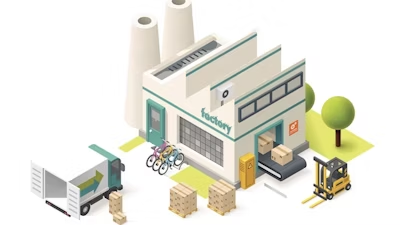Supply management In today’s fast-paced world, businesses are constantly seeking innovative ways to streamline operations and enhance efficiency. One of the most groundbreaking advancements in this realm is the advent of Supply management microfactory. These small-scale, highly efficient production units are not only revolutionizing manufacturing but are also setting new standards in How Supply management Microfactory Giving you Best in Supply management . How exactly is a microfactory giving you the best in supply management? Let’s delve into the intricacies of this transformation and explore the multifaceted benefits that microfactory bring to the table.
Table of Contents
Understanding Microfactory
What is a Microfactory?
A microfactory is a compact, versatile manufacturing facility that leverages advanced technologies to produce goods on a smaller scale compared to traditional factories. These facilities are characterized by their agility, sustainability, and ability to produce high-quality products with minimal waste.
Key Features of Microfactory
- Compact Size: Microfactory occupy significantly less space than conventional factories.
- Advanced Technologies: Integration of cutting-edge technologies such as 3D printing, robotics, and IoT.
- Sustainability: Focus on reducing waste and minimizing environmental impact.
- Customization: Ability to produce customized products quickly and efficiently.
How Microfactory Are Transforming Supply Management
Enhanced Efficiency
Microfactory are designed for efficiency. Their smaller size and advanced automation systems mean that they can produce goods faster and with fewer errors. This efficiency translates into several benefits for supply management:

- Reduced Lead Times: With production taking place closer to the point of demand, lead times are significantly shortened.
- Lower Inventory Costs: The need for large inventories is minimized as production can be ramped up or down based on real-time demand.
- Improved Responsiveness: Microfactory can quickly adapt to changes in demand, ensuring that supply matches customer needs.
Sustainability and Waste Reduction
One of the standout features of microfactory is their emphasis on sustainability. Traditional manufacturing processes often generate substantial waste and consume large amounts of energy. Microfactory, on the other hand, are designed to be more environmentally friendly:
- Energy Efficiency: Utilization of renewable energy sources and energy-efficient technologies.
- Waste Minimization: Advanced manufacturing techniques that produce less scrap and waste.
- Local Production: Reduced carbon footprint due to localized production and shorter transportation routes.
Flexibility and Customization
In today’s market, consumers are increasingly seeking personalized products. Microfactory are uniquely positioned to meet this demand:
- Custom Manufacturing: Ability to produce small batches of customized products without the need for retooling.
- Rapid Prototyping: Quick turnaround times for prototypes and new product iterations.
- Agility: Capacity to switch production lines rapidly to accommodate different products.
Cost Efficiency
While the initial investment in setting up a microfactory can be substantial, the long-term cost benefits are significant:
- Lower Labor Costs: Automation reduces the need for a large workforce.
- Reduced Transportation Costs: Localized production cuts down on shipping expenses.
- Decreased Overhead: Smaller facilities mean lower costs for utilities, maintenance, and other overhead expenses.
Image of How Microfactory Giving you Best in Supply management



Real-World Applications of Microfactories
Electronics Manufacturing
The electronics industry has been one of the early adopters of microfactory technology. Companies are leveraging these facilities to produce high-quality electronic components and devices with precision and efficiency.
Automotive Industry
Microfactory are making waves in the automotive sector as well. From producing small batches of custom car parts to facilitating rapid prototyping, the benefits are manifold:
- On-Demand Production: Ability to produce parts as needed, reducing the need for large inventories.
- Customization: Catering to niche markets with custom-built vehicles and parts.
- Sustainability: Implementing eco-friendly production processes to reduce the industry’s environmental impact.
Healthcare and Medical Devices
In the healthcare sector, the need for precision and customization is paramount. Microfactory are providing innovative solutions for producing medical devices and equipment:
- Customized Medical Implants: Creating patient-specific implants with 3D printing technology.
- Efficient Production: Streamlined production of medical devices to meet urgent healthcare needs.
- Quality Control: Ensuring high standards of quality and safety in medical manufacturing.
Challenges and Considerations
While the benefits of microfactory are clear, there are also challenges to consider:
Initial Investment
Setting up a microfactory requires a substantial initial investment in technology and infrastructure. However, the long-term savings and efficiencies often justify this expenditure.
Technical Expertise
Operating a microfactory requires specialized skills and knowledge. Companies must invest in training and development to ensure their workforce is equipped to handle advanced manufacturing technologies.
Scalability
While microfactories excel in producing small batches of customized products, scaling up production to meet large-scale demand can be challenging. Balancing scalability with the inherent advantages of microfactories is crucial for success.
How Microfactory Giving You Best in Supply Management
Streamlined Supply Chains
Microfactory are revolutionizing supply chains by making them more streamlined and efficient. With production taking place closer to the point of consumption, supply chains become shorter and less complex:
- Reduced Transportation Needs: Less reliance on long-distance shipping, reducing costs and environmental impact.
- Faster Delivery Times: Products can reach consumers more quickly, enhancing customer satisfaction.
- Improved Supply Chain Visibility: Advanced technologies enable better tracking and monitoring of the entire supply chain.
Increased Resilience
In an era of global disruptions, supply chain resilience is more important than ever. Microfactory contribute to this resilience by:
- Decentralized Production: Spreading production across multiple microfactory reduces the risk of a single point of failure.
- Flexibility: Ability to quickly switch production lines to different products in response to market changes.
- Local Sourcing: Greater reliance on local suppliers reduces vulnerability to global supply chain disruptions.
Enhanced Quality Control
Microfactory often incorporate advanced quality control systems that ensure high standards of production. This leads to:
- Consistency: Uniform quality across all products.
- Reduced Defects: Fewer errors and defects due to precision manufacturing.
- Customer Satisfaction: Higher quality products lead to increased customer satisfaction and loyalty.
Frequently Asked Questions (FAQs)
What is a microfactory?
A microfactory is a small, versatile manufacturing facility that uses advanced technologies to produce goods efficiently on a smaller scale than traditional factories.
How do microfactories improve supply management?
Microfactory enhance supply management by reducing lead times, minimizing waste, increasing flexibility, and lowering costs through localized and efficient production processes.
What industries benefit from microfactories?
Industries such as electronics, automotive, and healthcare are among the early adopters benefiting from the precision, customization, and efficiency offered by microfactories.
Are microfactories sustainable?
Yes, microfactory are designed to be environmentally friendly by using energy-efficient technologies, reducing waste, and minimizing the carbon footprint through localized production.
What are the challenges of implementing a microfactory?
Challenges include the initial investment required, the need for specialized technical expertise, and the scalability of production to meet large-scale demand.
Conclusion
The rise of microfactory marks a significant shift in the landscape of manufacturing and supply management. By offering enhanced efficiency, sustainability, flexibility, and cost savings, microfactory are providing innovative solutions to modern supply chain challenges. As industries continue to evolve and adapt to changing market demands, the role of microfactory in supply management will undoubtedly grow, paving the way for a more efficient and sustainable future. How microfactory giving you the best in supply management is not just a question of technological advancement but also a testament to the transformative power of innovation in reshaping the way we produce and deliver goods.


